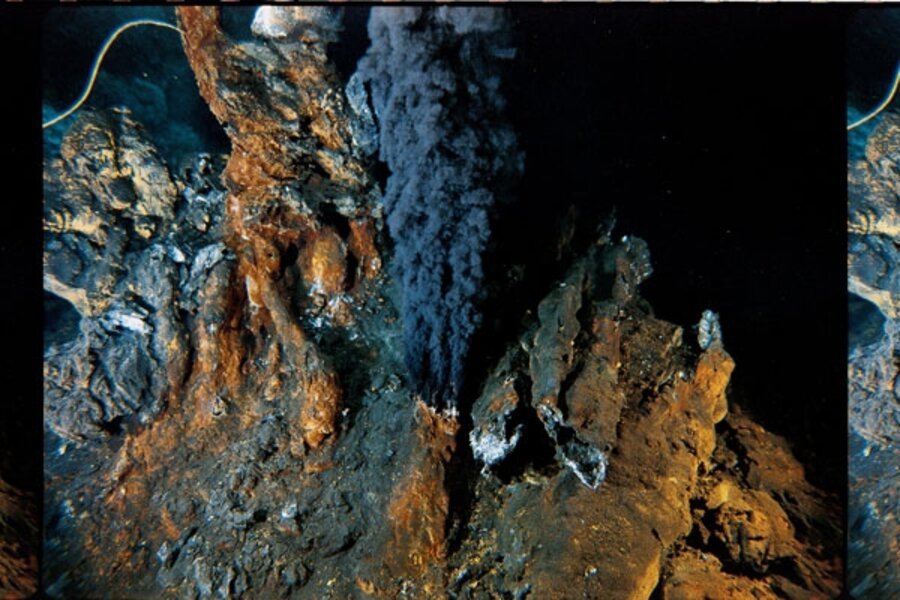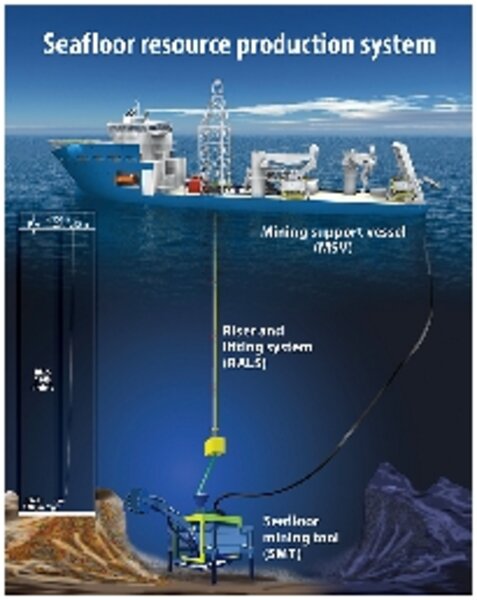Mining the ocean floor
| Woods Hole, Mass.
Pompeii worms, clams, and snails with iron scales armoring their feet are not exactly the cuddly icons that open checkbooks during environmental fundraisers.
But these denizens of the very, very deep are emerging as poster children for concerns about the environmental effects of mining minerals on the deep-sea floor – in particular, around hydrothermal vents that appear in vent fields dotting the length of the globe’s mid-ocean ridges.
For decades, the prospect that companies would seek fortunes on the seafloor has seemed remote, says Porter Hoagland, a marine-policy specialist at the Woods Hole Oceanographic Institution in Woods Hole, Mass.
From the 1950s through the ’90s, the dawn of the age of deep-sea mining was always considered to be 10, 15, or 20 years away, he says. “It was kind of a receding horizon.” But, he adds, conditions have changed.
Deep-sea exploration and extraction technologies have improved. Until the current global economic slump, rising prices for metals added luster to undersea deposits of gold, copper, and other metals. And the International Seabed Authority (ISA) – tasked under the Law of the Sea Treaty to set up rules governing mining and mining exploration under the sea – is moving to draft regulations governing prospecting and exploration of massive sulfide deposits.
The reason: Nautilus Minerals Inc. in Toronto has applied to the government of Papua New Guinea for a lease to mine deposits of copper and gold on the slopes of an active undersea volcano about a mile beneath the Bismarck Sea. Hearings on the application wrapped up in early April.
To be sure, Nautilus’s effort remains a baby step, given the unrealized, widespread hype over deep-sea mining in the 1960s, ’70s, and ’80s. Indeed, the regulations are being crafted “for an industry that doesn’t exist yet,” says Nii Odunton, the ISA’s secretary-general.
But the effort is being watched closely. To many researchers and environmentalists, now is the time to ensure that seafloor ecosystems have advocates at the table. Some marine ecologists are trying to figure out how regulators might set up marine-protected areas along mid-ocean ridges.
But, like deep-sea mining itself, the effort is tentative. Marine biologists haven’t thought much about strategies for minimizing the impact of mining on ecosystems found on or around massive sulfide deposits, says Cindy Van Dover, an oceanographer who heads the marine science and conservation department at Duke University’s Nicholas School of the Environment in Durham, N.C.
“This has not been on our radar screen,” she says. “And this has got to change.”
In many ways, renewed interest in seafloor mining has as much to do with scientists’ discoveries as it does with technology and economics. The first ecosystems around hydrothermal vents were discovered in 1977 along a rift in the eastern Pacific, between the Galápagos Islands and the South American coast. Since then, researchers have identified three types of ridges as they sampled a small portion of the 41,000-mile undersea ridge system.
First were the fast-spreading ridges, identified via the high level of geothermal activity scientists detected as they towed remote sensors through the plumes of hot material the vents erupted, notes Chris German, another marine scientist at Woods Hole.
As researchers discovered successively slower-spreading ridge types, few thought that they would host active hydrothermal hot spots. Hydrothermal activity was thought to tie directly to the speed of spreading.
But with each new type came the discovery that it, too, displayed significant hydrothermal activity. While vents on fast-spreading ridges were fueled by heat from plumes of magma pushing up close to the surface of the crust, the ultraslow ridges displayed a different type of heat source. Water heats as it seeps into deep faults that reach the bottom of the crust. It returns through fault networks to the ridge surface, picking up dissolved minerals and metals along the way.
From the perspective of mining exploration, sulfide deposits along ultraslow ridges have the potential for some of the highest yields. Exposed deposits can build over millenniums. On volcanically active ridges, fresh deposits often get buried by fresh lava flows or undersea landslides.
Yet even here, researchers say they have found significant sulfide deposits (often under sediment) away from ridge centers, where most of the action takes place. That difference between fast and ultraslow has a bearing on the marine ecosystems each type contains and how they might respond to mining disturbances.
On fast-spreading ridges, organisms may have adapted to sudden changes brought about by quakes and eruptions. On the ultraslow spreaders, one could imagine organisms there as the “old-growth forests” of the mid-ocean ridges – evolving over time under relatively stable conditions.
It might seem that after closely studying 200 to 300 active and inactive vent systems worldwide, researchers would have many of the answers they need to begin crafting conservation strategies. Yet, based on estimates of the number of vent fields along the ridges, this represents only about 3 percent or less of the world’s estimated vent fields. Researchers have barely scratched the surface as they try to gauge the biodiversity there.
Yet, ecologists may have enough experience with land-based and shallower marine ecosystems to offer a couple of plausible ways vent communities recover from a catastrophe, suggests Kim Juniper, a marine biologist at the University of Victoria in British Columbia.
Organisms may be hard-wired to recover in place. Or the devastated spot could get reseeded with larvae drifting in from elsewhere, leading to a far different mix of organisms from the ones that were there originally.
Scientists got a chance to check on the incoming-larvae idea following a series of eruptions on the East Pacific Rise in 2005 and 2006, he says. All the organisms in several vent communities were destroyed, although the vents continued to function.
“The really shocking thing about what happened here,” he says, “is that the organisms that repopulated the site came from 180 miles to the north. No one had seen them here before.”
That gives some sense of how far larvae travel and lends weight to the idea that a disturbed site may not host the same critters it did originally.
He and his team are now trying to monitor the area to see if the changes are permanent.
The implications of this for mining, he adds, are that when someone asks for a prediction of its effects, the answer is: It depends – on the distance to an alternative source of larvae, on the timing of organisms’ reproductive cycles, and on the changes mining can bring to the seafloor topography.
Such information is crucial if scientists and regulators try to design marine- protected areas when any mining operations are approved.
Craig Smith, a University of Hawaii biological oceanographer who has played a key role in designing marine reserves and protected areas, notes that reserves must be built in networks of protected areas large enough to contain a representative sample of ecosystems and close enough to allow for larvae to travel from one to the other quickly enough to reduce the chance of being eaten by predators. Ideally, reserves would protect 30 to 50 percent of each habitat type in a region.
“We should be thinking about these steps for hydrothermal vents and massive sulfide deposits,” he says. “Ocean ecosystems, including vents, are increasingly being impacted by human activity and urgently need protection.”






